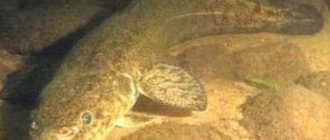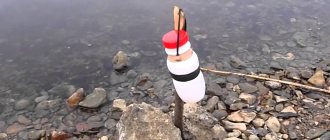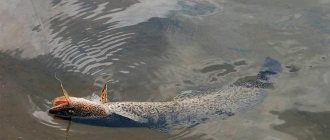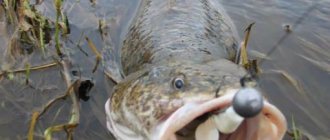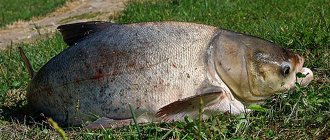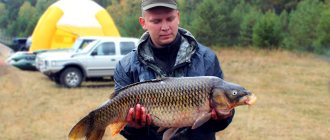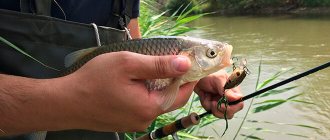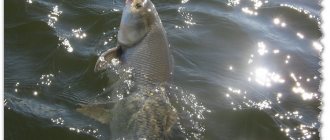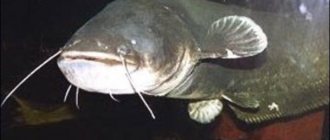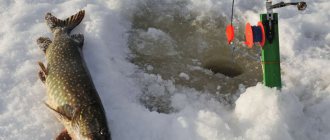Author of the article
Andrey Soprykin
Professional fisherman with 23 years of experience.
Articles written
85
Fishing for burbot in the fall allows you to get a rich catch. When the temperature in the reservoir drops to +11...+12 degrees, it begins to be active, unlike other predators, which, on the contrary, become passive. It is best to start fishing for this fish from the end of September. It is at this time that the temperature on the river drops to the required level, and burbot begins active hunting in preparation for winter.
Rice. 1. Burbot can grow to very large sizes (about 1.5 m).
Fishing location, preferred weather and time
Before you go fishing, you need to understand where to look for a predator. Fish from the cod family prefer areas with a rocky bottom, where they hide behind large cobblestones. Where to look in the fall: it can be found near coastal edges and pools, at the outlet of their holes near the shore, near snags submerged near the ground. That is, burbot lives where it has the opportunity to hide.
This fish goes hunting at night, so it is advisable to go fishing only at dusk and fish until the morning. A bite during the day is possible, but extremely rare. If you go when it is light, there is a risk of being left without prey, when the target is burbot.
Unlike many fish, this predator does not like sunny and warm weather. He prefers bad weather. Good bites are observed on windy and rainy nights. When going fishing in such weather, you need to take care of warm clothes, a waterproof raincoat, warm food and tea in advance.
We recommend watching a very useful video about catching burbot:
Features of catching burbot
First of all, it is worth understanding that burbot usually spawns in late autumn - early winter and prefers cold water of 12 degrees and below. Its second feature is that this predator prefers to be nocturnal and lives at the very bottom. Based on this, prepare for fishing carefully and taking into account the fact that you will have to spend a certain period of time, from several hours to days, outdoors in the cold season in almost darkness. Fishing for burbot in the autumn can be a serious test for an unprepared person.
On the donk
When deciding how to catch burbot in the fall, it is recommended to give preference to methods from the bottom. Donka fishing shows excellent results; there are two tactics:
- Active (sports). In this case, a small number of gears are used (from 1 to 3). The fisherman does not sit in one place, but constantly moves with the main bottom fishing rod, exploring new areas. You can also use a feeder, but slightly modified for burbot. This will allow you to quickly notice the bite and make a timely hook. However, you need to be prepared for the fact that you will have to spend time to get a good catch.
- Passive (deliverable). In this case, a large number of gears (up to several dozen) are installed on the river. The fisherman does not sit with them, he only walks around periodically, checking the catch. This kind of fishing with a donk involves the use of hooks or girders. To see a bite in a timely manner, you can equip these devices with bells or signal flags.
Expert opinion
Valery Andreevich Sizov
Professional fisherman with 35 years of experience
Please note! Each fisherman decides for himself how to catch a predator. The second method allows you to calmly relax by the fire, and the predator will be caught himself. However, there is nothing exciting or exciting about this. You can use these techniques simultaneously to get a big catch. That is, passive gear is placed along the shore, and the fisherman moves along it with a fishing rod to find the burbot’s resting place.
Fishing place
It is advisable to install a donk with an “elastic band” for burbot only in those places where you have already repeatedly caught burbot. Frequent bites in this place indicate that there is a burbot trail along which these fish go in search of food. Often, if the nature of the current and water relief does not change, burbots visit such “paths” for years. At the same time, in neighboring areas, which also seem to be visually suitable for fishing, it may not appear with the same persistence for many years.
Basic requirements for fishing line
Regardless of the gear used, the requirements for the leash and fishing line are identical:
- Possibility of quick replacement. Often the burbot grabs the hook too deeply, and pulling it out can be quite problematic. Therefore, it is recommended to use leashes with a fastener that can be quickly unfastened or prepare several pieces at once so that they can be trimmed if necessary.
- Use of tungsten equipment. Of course, burbot does not have such sharp teeth as pike. Therefore, it will take him time to gnaw through a regular fishing line. However, in a few bites he is able to do this. In order not to change the leash frequently, it is recommended to use tungsten. In addition, when fishing for burbot, pike can also bite.
- Thickness requirements: main line 0.4-0.5 mm, lead sinker and bait 0.3 mm. Such a large cross-section is due to the fact that burbot lives on a rocky bottom. There is a high probability that the equipment will catch on the cobblestones and get stuck between the boulders. Therefore, the stronger the line, the better. You can safely pull and release it without fear of tearing it.
Rice. 2. What is a leash with a clasp?
On a classic bottom fishing rod
Usually, conventional spinning does not bring results, because... Burbot has poor eyesight and may simply not notice the bait. It relies mainly on its sense of smell. Therefore, this tackle needs to be slightly re-equipped to make it a rod for jig fishing.
To do this, take a spinning rod with 10-20 g of dough and a sinker corresponding to this weight. The length of the rod should be about 2.7 m, with a fast action. A spinning reel with a 2500-3000 spool and braided line with a cross-section of 0.4 mm is suitable. You can use a bell on a leash as a bite alarm. It is installed on a stand to the fishing rod and clings to the fishing line in a gentle way, for example, with a weak clothespin.
To the feeder
This is an English fishing rod with a flexible rod tip, which is also a bite alarm. For equipment, monofilament fishing line or film with a cross-section of about 0.3 mm is used. At its end there is a feeder with a load and hooks. This makes it possible to simultaneously catch a predator and feed it so that it does not leave the area. The equipment used is a spinning reel with a 2500-3000 spool. For bait, you can use live bait, a bunch of worms, or larger cut fish.
When feeder fishing, you need to constantly monitor the tip of the rod if it is fixed to the ground. The tackle does not have a sound signal, like a jig. The bite can only be determined visually. If the feeder is in your hands, you can feel that the fish has bitten. After the predator grabs the bait, you need to immediately hook it. Otherwise, the filling will break or swallow the hook too deeply, which can damage the insides.
Rice. 3. What is feeder tackle?
How to prepare a feeder for burbot
The feeder uses a type of removable leash 40 cm long, as well as a main line from 0.2 to 0.3 mm, a lead line of 0.2-0.25 mm. To catch low-blind burbot, the thickness of the fishing line can be neglected; attention should be paid to equipping the feeder with as fleshy and fragrant bait as possible.
Before casting the fishing rod, the feeder is filled with intensely smelling food in the form of offal, pieces of cut fish, and liver from the nearest supermarket. A kind of “sandwich” of sequentially attached particles of liver, fish, and live wriggling worms is attached to the hook as bait. All this is sprayed with a special spray to stimulate the appetite of individuals. The bait moving on the hook attracts the keen attention of a night predator, increasing the likelihood of a successful hunt for it.
Installation of a snack
The zakidushka is the simplest bottom tackle of the passive type. It can easily be made from scrap materials:
- Tie a hook to the fishing line.
- Use an angular stone tied with hemp twine as a sinker.
- Secure the second end of the fishing line to a peg.
- Drive the holder into the ground on the bank.
The advantage of such bottom tackle is that it takes up little space and is light in weight. If you wish, you can take several hooks with you on a fishing trip and place them along the entire shore. In addition, you don’t need to spend a lot of money on such gear. They are made by hand.
Expert opinion
Valery Andreevich Sizov
Professional fisherman with 35 years of experience
Note! You can place the dumpsters in the evening, and come check them only in the morning. This eliminates the need to sit on the shore all night and wait for a bite. If a burbot grabs a hook, it won’t go anywhere, even if it stays on it for several hours. The most important thing is not to leave this bottom tackle unattended for a long time near snags, sunken branches, etc. There is a risk that a predator will become entangled in them.
Rice. 4. Homemade snacks.
The best baits
It is impossible to say exactly what the predator bites best on. It all depends on its size, usual natural food, weather conditions, etc. Therefore, you will have to select the most suitable bait experimentally.
Zywiec
This bait always works well. Fry or young individuals of various fish can be used as live bait. The bait is placed on the upper lip or behind the back. You don’t have to injure the live bait and use a double hook with a long shank and a leader. They are introduced into the mouth and carefully removed from the gills. Which fish to catch is decided through trial and error.
The gudgeon is most popular among experienced fishermen. This small fish is found in large numbers in all water bodies, so it will not be difficult to catch it for bait. In addition, gudgeon is the natural food of burbot, so it will willingly go for such live bait.
You can use loaches with antennae. It lives in small bodies of water and is not difficult to catch. This live bait is recommended for fishing in small rivers.
In third place in popularity is the ruff. It has a strong odor that burbot can smell from several meters away. This live bait can even be used for fishing without hooks. It must be securely tied to the fishing line by the tail and lowered into the pond. The predator swallows its prey head first. If you pull the line at this moment, the ruff will straighten its spines and get stuck in the throat.
Expert opinion
Valery Andreevich Sizov
Professional fisherman with 35 years of experience
Note! If none of the fish listed above can be caught, then you can use roach, crucian carp, even young animals of large predators. But it should be borne in mind that those species that live on the surface of reservoirs are unusual prey for filling. Therefore, he will be reluctant to go to them.
Fish pieces
If the live bait has died, it makes no sense to plant it in its entirety, because he still won't move. It's better to cut into pieces. This way it will smell stronger, and the predator will smell it from afar. You can also use store-bought freshwater fish. If you have sea food in stock, that will do too.
Expert opinion
Valery Andreevich Sizov
Professional fisherman with 35 years of experience
Note! This bait is only effective for 3-4 hours. Then it will lose its aroma or be eaten by other inhabitants of the reservoir.
Frog
Some fishermen claim that it is the best bait. Others say it is of no use. In fact, it all depends on the place of fishing. If there are frogs in a pond with burbot, then he feeds on them and knows what they are. If the predator has never seen them, then most likely he will refuse such a treat. In any case, when determining what burbot bites in a particular place, you need to try frogs. They are placed behind both lips or behind the back (under the ridge).
It is best to use two-year-old frogs or slightly older yearlings as bait. The most favorable time for catching them is August. Then they can be kept in a cool room (for example, in a cellar) in a container with damp grass. The container must be closed with a lid, otherwise the frogs will run away. The most important thing is not to forget to make holes in it for air to enter. Avid fishermen specifically purchase an aquarium with a pond for amphibious turtles. It is periodically cleaned and the water is changed.
Worms
They need to be dug up in the summer or early autumn, when it is still warm. At this time, they dig passages in the surface of the earth; they are easy to find. With the onset of cold weather, they go into the depths. You can store them in a jar with soil in a cool place, for example, in a refrigerator or cellar. You need to plant large or medium-sized specimens, but in a bunch.
How to catch burbot in the fall on a feeder
Today we offer the topic: “how to catch burbot in the fall on a feeder” from professional fishermen. We tried to cover the topic as fully as possible. You can ask all questions in the comments after the article.
Burbot is a cautious fish. Likes to hide in reliable shelters and snags. With the onset of cold weather, the vital activity of fish decreases. It seems that the cold water is completely devoid of fish. But catching burbot in the fall on a feeder can sometimes bring good results, especially if you know how and where to fish.
When the weather suddenly worsens and gets colder, you should look for this fish in the area of whirlpools, near underwater rock ridges. That is, in areas with a favorable oxygen regime and the presence of reliable shelters in which burbot spends the summer. With the arrival of autumn, in such places it is possible to catch burbot using a feeder, and a bite is almost guaranteed.
It is better to search for this species in small lakes, in clean and fast rivers. Observations by scuba divers in the autumn-winter period show: the cleaner and smaller the body of water, the larger the individuals that live in it.
Therefore, burbot fishing is carried out in shallow reservoirs, and the most likely location point is considered to be the bottom at a bend in the river bed, near a washed-out bank, underwater stone embankments, areas with clay or rocky soil, sand shoals and riffles. A pit cluttered with snags with a rocky strip is an ideal hunting point for burbot.
The border between a fast channel and a calm water surface is suitable for fishing. It is interesting to try fishing on the lower edges of sandbanks and islands.
This species is considered one of the few fish from the cod family that live in our reservoirs. Codfish originate from northern rivers flowing into the waters of the Arctic Ocean, and burbot has corresponding characteristics of habit and behavior.
The cold season is simply ideal for burbot. When the ground is already covered with snow and the rivers are not frozen, the most fabulous period begins, the pre-spawning feast of this predator. Burbot begins to spawn after the ice has formed. During the spawning process, the predator does not consume food.
The quality of the fish bite depends on the weather. In unstable weather at the beginning of autumn, burbot begins to be caught on the feeder. Mostly, these accidental captures occur during breaks in the weather - on stormy days with sudden drops in temperature and atmospheric pressure.
The closer the season is to winter, the more intense the bite becomes. But you can count on a good catch using a feeder rig only when the water temperature in the river drops below 10 degrees Celsius. For the middle zone this is at the end of October or beginning of November.
10-15 days before freeze-up, the fish begin their pre-spawning feast. At the same time, inexperienced fishermen are given the false impression that burbot is easy to catch on a feeder in the fall. This is not entirely true, although there is no difficulty in catching this fish. It's hard to find her.
Therefore, it is worth first studying the fishing tackle for November fishing for burbot, and then thinking about ways to catch it on a feeder. Fishing is carried out with an ordinary donka. It is the simplest equipment for autumn burbot fishing. Another option is the so-called feeder.
A blind bottom is a rigid rod with a main line 4-5 m long and 0.3-0.4 mm thick. The length of the fishing line is equal to the length of the rod. In addition, the tackle includes a sinker with a loop, attached to the loop at the end of the main line, and a leash with a length of 25 cm to 50 cm and a thickness of 0.2-0.3 mm. with hook No. 8−10 and long shank.
But in practice, the gear is even more simplified. The fishing line has a thickness of 0.25-0.3 mm, the leash has the same parameters, the hook is used No. 10-12 with a long neck. The sinker has any shape, with weight proportional to the flow. Typically, a load weighing 40−100 g is used.
There are various options for this equipment. The use of a reel is allowed, but it is of no use to the angler. It is possible to use Bolognese and feeder rods for autumn burbot fishing, descriptions of which are posted on numerous videos.
At the same time, the essence of the gear does not change. Donka is a donka. Fishing is carried out with sports fishing rods, feeders, Bolognese fishing rods and for them these properties correspond.
In fact, the given figures are considered conditional; to replace the fishing line, it is allowed to use both rope and nylon cord. A nut or stone is effectively used as a sinker. This will not change the bite. Regardless of the quality and design of the gear, it can be used for fishing.
During feeder hunting for burbot, there are no significant differences from regular fishing using donkey. The main difference is the use of durable Heavy class fishing rods and feeders.
To catch burbot on a feeder in the fall, as a rule, a pair of feeder gear is used in order to quickly determine the path of movement of individuals. In this case, the bait is sent to various distances. With the help of a bite, the place of intensive movement of fish is clarified, which is an advantage compared to other donks.
The feeder tackle is equipped with a massive triangular-shaped feeder, weighing up to 120 grams, to avoid drift by water flows. For places with little current, a sample weighing from 60 to 80 grams is used.
The feeder uses a type of removable leash 40 cm long, as well as a main line from 0.2 to 0.3 mm, a lead line of 0.2-0.25 mm. To catch low-blind burbot, the thickness of the fishing line can be neglected; attention should be paid to equipping the feeder with as fleshy and fragrant bait as possible.
Before casting the fishing rod, the feeder is filled with intensely smelling food in the form of offal, pieces of cut fish, and liver from the nearest supermarket. A kind of “sandwich” of sequentially attached particles of liver, fish, and live wriggling worms is attached to the hook as bait. All this is sprayed with a special spray to stimulate the appetite of individuals. The bait moving on the hook attracts the keen attention of a night predator, increasing the likelihood of a successful hunt for it.
First of all, you should understand that this species is a sublunar scavenger and a predatory fish, so night fishing is most successful for catching it. A permanent bottom fishing rod does not require control, since the burbot itself is hooked onto a baited hook.
If the location is chosen correctly, it is enough to leave the fishing rod overnight, and in the morning remove the caught prey from the hook. If the ground of the reservoir is level, this tackle is used without a fishing rod at all.
If it is necessary to control the bite and keep the bait alive, special attachments are used on the end of the rod with rattles and bells to signal the bite. In night fishing, luminous attachments on the rod are used, by which you can easily visually determine the bite, observed as a very sharp and quite strong pull, or a series of jerks.
When biting, there is no need to rush; it is acceptable to wait a minute or two - the fish, as a rule, ends up on the hook. After the burbot is caught on the hook, the most important and difficult task remains - removing it from the hook.
The hook is swallowed deeply by the burbot. Removing a hook from a fish's womb takes a lot of time unless special devices are used. To extract the hook, special extractors are used, sold in specialized fishing stores. It is recommended to use ordinary woolen work gloves to handle very slippery fish.
Burbot is both a scavenger and a predator; it is not caught using bait of non-animal origin.
Live and dead fish and worms are used as the main bait. In addition to these baits and groundbaits, you can use anything. The following types of baits and groundbaits are usually classified:
Live insects:
Cut fish:
Live amphibians:
The situation is complicated by the fact that in different regions this species bites on different baits, and choosing the most effective one can only be done through experiments.
Fishing is possible using different baits, for example, live bait. For an ordinary river in the middle zone, the most universal bait is the meat of common river carp, cut into strips about a centimeter wide.
Lure
There is no need to feed burbot in the fall. For fishing, fairly large and odorous baits are used, so the predator comes to them from afar. However, those who have tried feeding fish note a positive effect. She manages to be detained in one place and even brought to him. Plant components are not suitable as bait. You need to use balls made from minced meat, chopped worms, meat, its by-products, etc.
Summing up, we can conclude that it is best to go for burbot at the end of September, when the water temperature drops below +13 degrees. At this time, he becomes active and willingly takes various baits of animal origin. For fishing, you can use both active and passive tactics. To catch a large number of fish, it is recommended to combine two methods. That is, place the nooks along the shore at a distance of 10-15 m from each other, move in parallel with a fishing rod, exploring the most interesting places.
Getting to know the fishing object
The individual has a spindle-shaped body, covered with small scales and tapering towards the tail, a small flattened head with bulging eyes. The upper jaw is larger than the lower jaw. The main distinguishing characteristic is the long mustache on the lower jaw. The fish can reach 1.2 m in length and weigh 24 kg.
Features of behavior . Burbot prefers to live in clean waters with a rocky bottom and a pronounced current. It can be found in holes, near stones, snags, and in the roots of trees growing near water. The optimal period for fishing occurs when the water temperature is no higher than 12-13 degrees Celsius. At 15 degrees Celsius, the activity of the individual decreases sharply, and it seeks shelter at the bottom, where it waits out the heat.
Spawning time occurs in December and January; the fish bite is weak at this time. It is extremely rare that they are caught on a hook, and even then they are small, immature specimens.
In the autumn, the burbot begins to eat, and it is very active . When hunting, this predator uses almost no vision, relying only on the smell of prey and information received through the lateral line.
Baits and groundbait
Burbot is a predator, so both bait and groundbait must be made from live ingredients. In this capacity they mainly serve:
- maggot,
- bloodworm,
- red dung worms and crawling,
- pieces of fish,
- live bait or live frog,
- chicken giblets.
